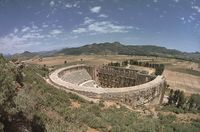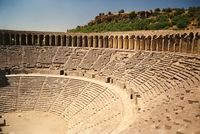Aspendos was an ancient Pamphylian city. It has the best preserved ancient theatre in the world. With a diameter of 96 metres, the theatre provided seating for 15,000 people. Other Roman ruins stand close to the theatre.
History
Aspendos was an ancient city in Pamphylia. It was situated on the Eurymedon River, about 16 kilometres inland from the Mediterranean Sea. It shared a border with, and was hostile to, Side.
The Hittites recorded a city called Asitawanda, where they traded horses, which was probably the Bronze Age name of Aspendos. This suggests that, like Perge, Aspendos was established long before the Iron Age.
Aspendos was one of the earliest cities to mint coins, first staters and later drachmas. The wide range of its coinage found throughout the ancient world indicates that, by the 5th century B.C., the Greek city had become the most important in Pamphylia. At that time the Eurymedon River was navigable as far as Aspendos, and the city derived great wealth from a trade in salt, oil, and wool. Aspendos continued to issue coins until the late Roman period.
In 333 B.C., Aspendos paid Alexander the Great a levy to avoid being garrisoned. It ignored its agreements with him, and later was occupied. In 190 B.C. the city surrendered to the Romans, who later pillaged it of its artistic treasures.
Aspendos went into decline towards the end of the Roman period. This decline continued throughout Byzantine times.
Archaeology
Aspendos is known for having the best preserved ancient theatre in the world. With a diameter of 96 metres, the theatre provided seating for 15,000 people and is probably the finest ever built.
The theatre was built in 155 A.D., by the architect Zenon, a native of the city, during the rule of the Roman Emperor Marcus Aurelius. In keeping with Hellenistic traditions, a small part of the theatre was built so that it leaned against the hill where the Citadel (Acropolis) stood. The remainder was built on vaulted arches.
Post holes for 58 masts are found in the upper level of the theatre. The masts supported a velarium (awning) that could be pulled over the audience to provide shade.
The high stage served to seemingly isolate the audience from the rest of the world. The backdrop has remained intact. The 8.1 metre sloping, reflective wooden ceiling over the stage has been lost over time. In the 13th century, the Seljuks converted the stage building into a palace.
The Seljuks repaired the theatre from time to time, and used it as a caravanserai.
Near to the ancient theatre stand the remains of a basilica, agora, nymphaeum and 15 kilometres of a Roman aqueduct. The remains of a siphon system are the only known surviving example in the world. The Roman Eurymedon Bridge, reconstructed in the 13th century, is also in the vicinity.
The present day
Until very recently, the ancient theatre was frequently used for concerts, festivals and other events. Due to damage being caused by modern theatrical equipment, the authorities opened a new, modern facility nearby.
The Aspendos International Opera and Ballet Festival, organized by Turkish State Opera and Ballet, has been an annual event since 1994. Each year, the cast of international opera and ballet companies attracts an audience of about 10,000 people to the ancient theatre.
Key Facts
- Aspendos is found 94 km from Alanya, on the west side.
Shorex: Aspendos is a great full day excursion for enthusiasts of archaeology, but also combines well with 12.



